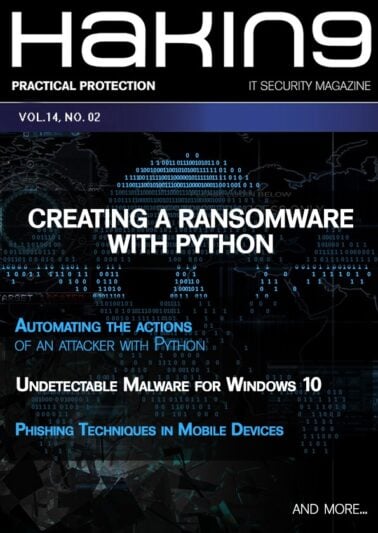No products in the cart.
- You cannot add "Drone Wi-Fi Hacking (W33)" to the cart because the product is out of stock.
Download
File H9_Cyberbiosecurity_Preview.pdf
Dear Readers,
In the August issue of Hakin9 Magazine, we craved to bring you closer to the mysterious topic of Cyberbiosecurity. It is an emerging area interfusing the matters of biomedical engineering, cybersecurity, vulnerable biodata, and many more.
As a hacker, pentester, engineer, or enthusiast in another similar background, you probably mostly encounter regular cybersecurity topics that do not necessarily touch on biodata. However, due to the times we live in, it is pivotal to turn to this topic since we unwittingly generate biomedical information. And this, like any other type of data, is susceptible to all kinds of vulnerabilities.
For instance, if you have ever engaged in a blood donation, or a use of a smartwatch, smartband, or any device that gathers facts about the processes occurring in your body, you will surely get your neurons excited about our current Hakin9 issue!
In the article ‘Cyberbiosecurity: a New Context for the Fourth Industrial Revolution’, you will take a leap into the cyberbiosecurity universum with digital transformation in the background.
Next, the topic of cyberbio convergence is described with details concerning both the benefits (such as seamless data access) and non-negligible drawbacks (such as weaponizing DNA).
Later on, our authors paint a picture about how biohacking is expanding human capacity. They acknowledge the possible increase of our capabilities, as well as potential safety vulnerabilities.
Especially for our SOCMINT connoisseurs, we have an article about its utilization in tracking, identification, and combat in counter-terrorism operations. The author discusses the area of social media intelligence and brings up the tools you can use even now! Our personal favorite is one of the last sections which is about behavioral and linguistic analysis.
The next subject, which is essential to touch on in the cyberbio realm, is bringing cybersecurity to bioinformatics. This article reviews sensitive data protection in biomedical research.
Another article is in an unconventional form. This is a story titled ‘The Hunting of the Web Shell’. It introduces the reader to the thought processes present in a web pentester's mind.
Afterward, we present you with the interview with John-André Bjørkhaug, who is a penetration tester at NetSecurity in Norway. We raise the subjects of social engineering, Managed Service Providers, and advice for the younger in the cybersecurity space.
Next, we have a comprehensive piece about stopping ransomware using filtering and deception. Our author, who spent over 20 years in the US Navy, debates malware derivative ransomware and approaches to cease it. It is a very practical article which you can benefit from immediately!
Later, our author familiarizes us with a very handy tool - DNS Reaper. It will be valuable for so many cybersec enthusiasts: an attacker, bug hunter, defender as well as a professional DevSecOps.
Last but not least, we have an article about how to build an OT cybersecurity program. The author proposes solutions and the organization of such arrangements.
We are confident that this issue will help you broaden your cybersecurity knowledge immensely, since it encompasses not only the subjects of cyberbio dimension, but also SOCMINT, ransomware control, pentesting and others!
Stay safe,
Hakin9 Editorial Team
TABLE OF CONTENTS
Cyberbiosecurity: a New Context for the Fourth Industrial Revolution
Dr. Anthony Caldwell
The impressive success of the digital economy comes fraught with risks as well as rewards. In this respect, a focus of intense interest surrounding the relevance of cybersecurity has penetrated into many areas of computer science, economics, AI and law to name a few. In today’s highly interconnected world, an increasingly wide variety of applications are subjected to security attacks. Of particular concern are the bioinformatic systems which store patient/customer medical data and the institutions themselves that gather it. This paper introduces some of the important themes developing within the discussions on cyberbiosecurity through the lens of the fourth industrial revolution and highlights some of the crises that may yet emerge.
CyberBio Convergence
Atlas Stark
The world of technology is ever-changing and with those changes come innovation and challenges, some good and some not so positive. Cyber-bio convergence specifically, is a technological advancement that holds the answers to many legacy problems, especially within the field of medicine, as well as offering fresh solutions for better living. You may be asking yourself, what is cyber-bio convergence? Let’s explore that together.
How is Biohacking Expanding Human Capacity?
Joas Antonio, Nivea Moura
Biohacking refers to using biology with a hacker's mindset. There is still no single, established definition of the term. Biohacks promise anything from rapid weight loss and improvements in motor functions to expanding brain capacity. Furthermore, it is a very broad concept, as described by the Rathenau Institute: 'The human body has become a quantifiable object, a collection of 0's and 1's that can be measured, mapped, manipulated, monitored and improved upon, and upon which you can intervene, make more efficient, influence and control.’
That's why it's become the fastest growing community, sharing tips and techniques to help enthusiasts conduct structured experiments on themselves outside of a controlled experimental environment, such as a lab or doctor's office. However, there are several risks and points of attention, which I intend to address in this article.
SOCMINT for Tracking, Identification, and Combat in Counter-Terrorism Operations
Felipe Hifram
The integration of digital technologies into everyday life is something that undeniably grows at a fast pace, and this growing social transformation of the digitization of human life can be considered one of the great milestones of this century. We are facing a society where people under 40 are incredibly active in the digital world, having high familiarity and ease of use of various online services and a strong presence on social networks. As a highlight, the Asian continent trumps any other, containing around 60% of global social media users according to 2020 data. Of course, this growth was expected to involve creating new opportunities for people, and indeed, there has been growth in various sectors of society, from job creation to political participation, civic action and activism. And, of course, this growth favors not only positive but also negative movements, and this poses challenges for authorities, not only in Asia but across the world.
Bringing Cybersecurity to Bioinformatics: Protecting Sensitive Data in Biomedical Research
Muskan Bansal
As biological fields continue to grow to utilize rapidly developing technologies, the need to address technological vulnerabilities is necessary for these fields to continue to grow while keeping data and research secure at the academic and industrial levels. This paper will focus on introducing cybersecurity enthusiasts and experts to academic and industrial biomedical research laboratory setups, discuss areas of threats and vulnerabilities in this field, and share top mitigation strategies.
The Hunting of the Web Shell
Nikolaos Tsapakis
This article is in an unconventional form. It is a story titled ‘The Hunting of the Web Shell’. It introduces the reader to the thought processes present in a web pentester's mind.
MSP, Social Engineering, Pentester's Advice: Interview with John-André Bjørkhaug
Here, we present you with the interview with John-André Bjørkhaug, who is a penetration tester at NetSecurity in Norway. We raise the subjects of social engineering, Managed Service Providers, and advice for the younger in the cybersecurity space.
Stop Ransomware in Its Tracks Using Filtering and Deception
Kevin Cardwell
If you follow any of the latest attacks that make the news, you have no doubt seen that these attacks are for the most part related to some form of a malware derivative ransomware. While it is true to some extent that these attacks have continued to increase in both sophistication and complexity. The reality is that any organization who has had the unfortunate experience of being a victim of this attack should not have lost the ability to perform either their network requirements or mission requirements in the case of military or government networks; furthermore, any organization or entity who has lost their entire network more than likely has a poor network design to blame. Even a network that follows the basic best practices tenets with respect to security would be enough to prevent the loss of the entire network capability. In this article, you will learn about these fundamental design concepts that will allow you to protect your network and/or enterprise from the majority of these attacks. You will get the most out of the article if you have a foundation and understanding of networking.
DNS Reaper
Sarthak Thakur
Subdomain acquisition is a target for hackers, very profitable for steam hunters and a thorn in the side of security teams. As businesses use more cloud and SaaS services, the opportunity to acquire DNS subdomains increases significantly. DNS changes are now done through developer-provided permissions and a more decentralized approach than DNS. Once attackers have the victim's domain, they can use it for phishing campaigns that bypass spam checks and steal empty cookies. DNS Reaper is a subdomain hijacking tool, but our arsenal focuses on accuracy, speed, and number of signatures. It can scan approximately 50 subdomains per second, each with more than 50 takeover signatures. This means the entire DNS can be scanned within 10 seconds. This tool is developed by Punk Security Limited. Punk Security Limited specializes in integrating security into the DevOps pipeline, enabling rapid and secure development.
How to Build an OT Cybersecurity Program
Mohamad Mahjoub
Facilities that aid economy, public safety as well as public health are categorized under the umbrella of critical infrastructure. Due to the exploding digital transformation that is happening in recent years in the critical national infrastructure, there is a path nowadays for attackers to run from spoofed email in an email inbox all through the network to the ICS crown jewels and industrial assets. We learned a lot from the recent industrial attacks that took place in 2021 and 2022; we learned that the initial attack vector is usually simple due to poor security perimeter, we also learned that ransomware gangs are maturing more and more, and we learned that when there is a critical public service on the line, there is more chance that the ransom will be paid. Critical environments cannot afford to fail. An operational outage of even a few seconds when public safety is at stake is not tolerable. We need to build in cyber resilience so these systems are able to resist and fight back against cyber-attacks. IT and OT are different, and this is why.
Only logged in customers who have purchased this product may leave a review.





Reviews
There are no reviews yet.